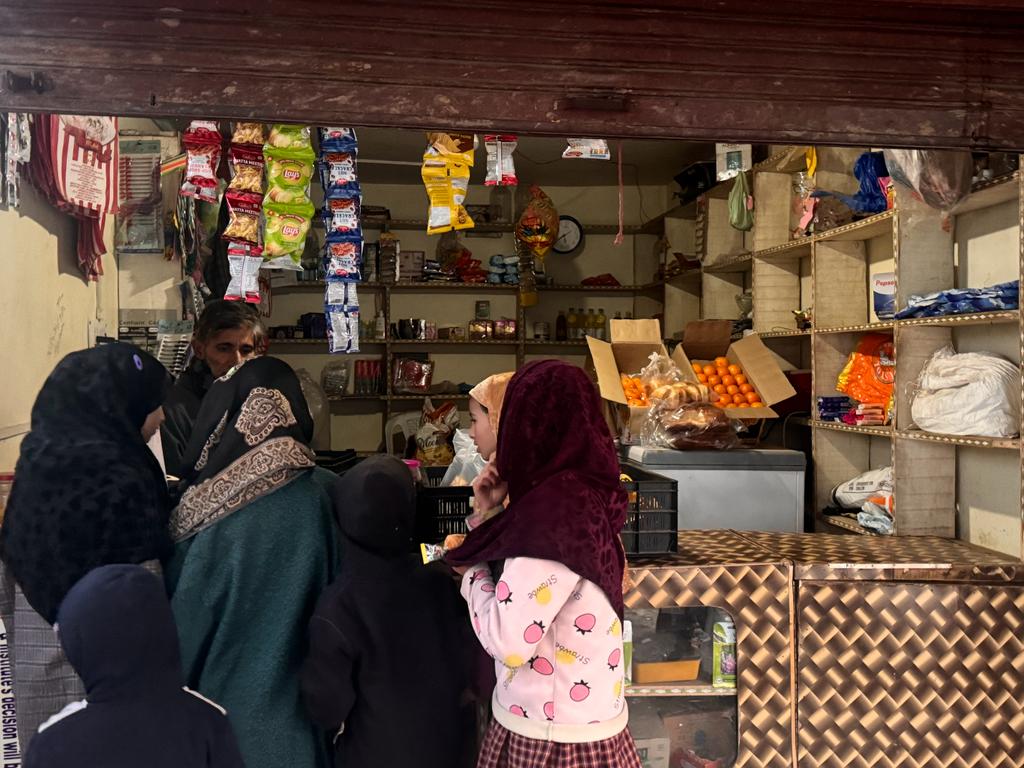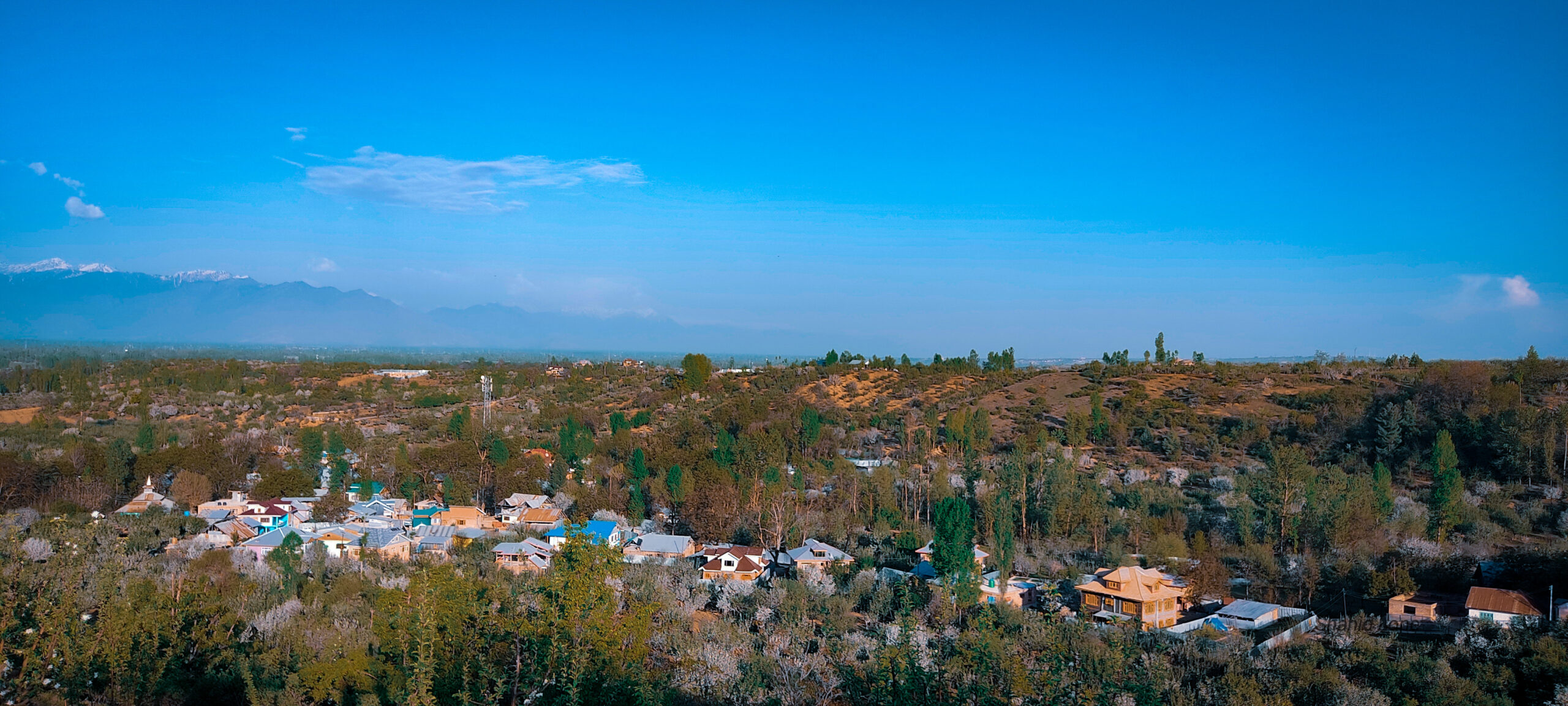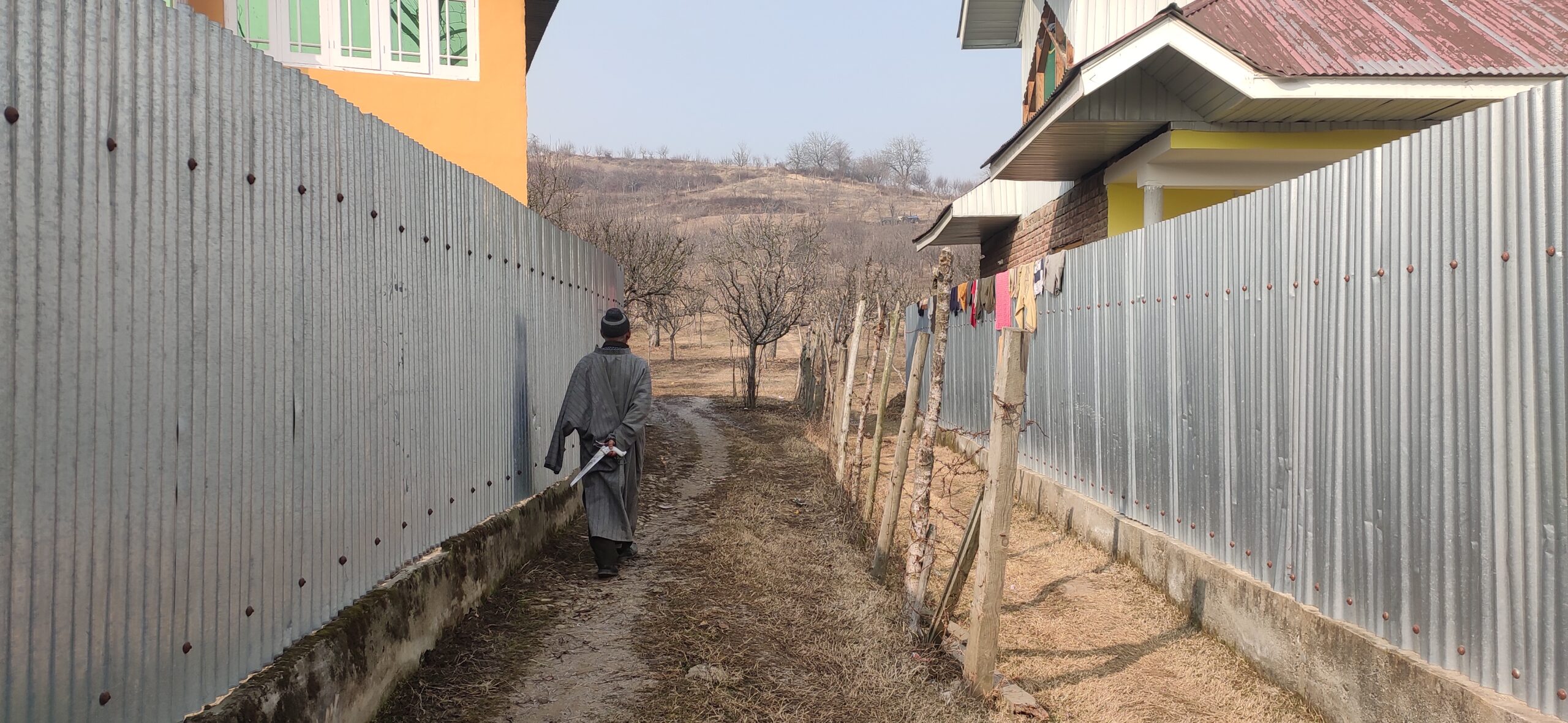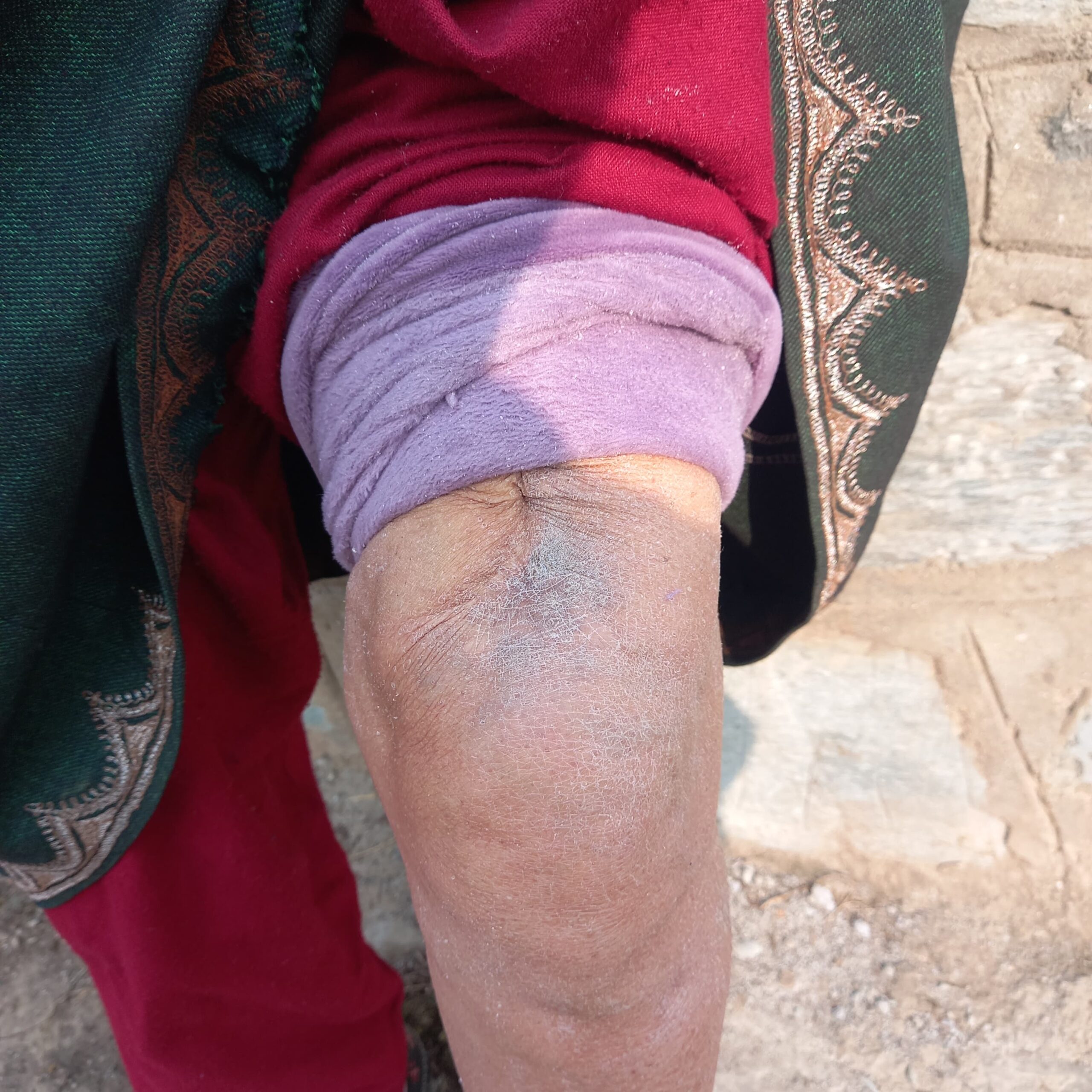
Shahid ul Islam
In the heart of nature’s embrace lies Budan, a village in Kashmir’s north, adorned with lush flora and vibrant fauna, encircled by bountiful apple orchards.

The rhythmic hum of agricultural activities resonates through the air as every villager tends to their orchards, cultivating a livelihood in harmony with the thriving landscape. Today, Budan stands as a flourishing community, boasting over 100 houses that bear witness to the symbiotic relationship between the people and the fruitful land they call home.
In the quiet village nestled within the Baramulla district of Kashmir about 80 kilometers north of Srinagar, lives were forever altered by a conflict that left scars both physical and emotional.
The scars of harrowing gunfights continue to cast a shadow over the lives of its residents. Some days that began like any other turned into a nightmare, leaving behind shattered lives and a community grappling with the aftermath of a tragic series of conflicts.
The haunting memories of a tragic gunfight still linger, serving as a painful reminder that residents wish to forget.
Unveiling the Layers of Tragedy
In a poignant account, 70-year-old Muhammad Sultan, clad in a traditional pheran (the traditional outfit worn by both males and females in Kashmir is particularly designed to protect oneself from the coldest phase), with the weight of experience etched on his face, stood atop a local shop, recalling one of the gunfights that took place on 5th June 1993, marked by brutality reminiscent of contemporary Bollywood movies. His wizened gaze told the tale, as he somberly expressed, “What brutality we witnessed on that fateful day mirrors the scenes portrayed in today’s Bollywood movies of the encounter genre.” After a moment of reflection, he added with a solemn tone, “Allah ta‘ala bachayeen as’si tumhou doho nish” (May Allah protect us from such days), before quietly leaving.
The gunfight unfolded with a grim toll—no. of Indian Army personnel and locals emerged unscathed, and three local militants lost their lives in the tragic confrontation. Ghulam Hassan, a survivor of the ordeal, once fueled by the aspiration to become a successful entrepreneur in the agriculture sector, saw his dreams shattered when a bullet struck his leg during crossfire during this gunfight. Hassan, now managing a local grocery store in the very village with a prosthetic leg, stands as a living testament to the indomitable spirit of those who have endured unimaginable pain.
Eyewitnesses, reluctant to revisit the horrors of that day, recounted a scene of chaos and despair. “We don’t want to remember that day,” one witness expressed, capturing the collective sentiment of a community scarred by the traumatic event. “I don’t believe such gunfights have occurred or will occur anywhere in Kashmir,” declared another eyewitness Mohammed Subhan, reflecting the disbelief and shock that lingered in the aftermath. After taking a few footsteps before embarking on pruning apple trees in his orchard, he added, “The village was engulfed in a torrent of violence, with the echoes of bullets shattering the once serene atmosphere.”

An elderly woman, Haleema Begum, recalling the day painted with a vivid picture of the brutality faced by the villagers. The symphony of gunshots that tore through the village left blood stains in its wake. “I thought it was our last day. Bullets flew from every direction, leaving at least 10 to 20 Indian Army personnel injured and several others dead. In the aftermath of the intense gunfight, injured army personnel were lodged temporarily in diverse residences near the encounter site due to the unpredictable volatility of the gunfire. Upon our return home the next day, a disconcerting revelation awaited us, our bedspreads, comforters, and blankets were stained with blood. These items had been utilized by the soldiers to staunch the wounds of their injured comrades, preventing further hemorrhage,” she recounted, the pain evident in her weathered eyes.
The trauma extended beyond the physical wounds, as survivors grappled with the emotional toll inflicted by the tragic event. Another survivor, Bashir Ahmed, marked by bullet wounds on his head, lamented the loss of health and livelihood. “I am not able to work as I used to before this injury,” he admitted, shedding light on the profound economic and emotional impact suffered by those caught in the crossfire.
Before another gunfight several months later, a former local militant, now surrendered, extended an invitation to fellow local militants for lunch at his home. During this happening, a relative of another local militant (who was one of the fellow militants invited for lunch) hailing from the identical village fell ill, prompting this militant to transport the ailing family member alongside other relative to hospital. The army, somehow becoming aware of this situation, captured the militant aiding the patient, triggering a swift gunfight in the village between militants and Indian army personnel. Tragically, amidst the crossfire, a local woman lost her life. The intense exchange resulted in the demise of four local militants, with significant damage inflicted upon the Indian army. Salim, a close relative of the woman who lost her life, shared, “We only have a few photographs of her; I was around 5 to 6 years old at the time of that incident. Even today, the entire village reminisces about her hospitality.”
In a grim turn of events, the gunfights in Budan Rafiabad not only claimed the lives of Indian Army personnel but also saw militants meeting a tragic end. The house where the militant took shelter in one of the gunfights was razed to the ground, and remnants of local militants were carefully extracted from the damaged structure and laid to rest. A local resident, requesting anonymity, disclosed that a clandestine meeting had taken place among militants on that fateful day, involving approximately 30 to 40 militants, both local and non-local. While a majority managed to evade capture, a somber reality remains—some faced the fatal consequences of the encounter.
In a distressing episode that occurred after a few days of this gunfight, Sitara Begum, 50-years old now, became the target of aggression by a member of Ikhwan-ul-Muslimeen (The pro-Indian government militia that targeted Pakistan-backed militants operated in Kashmir during that time). When she staunchly resisted his (Ikhwan man’s) attempt to take her son, refusing to comply with his demands, she faced the horrifying consequence of his actions as he callously opened fire. The resulting bullet wounds in her leg serve as a painful testament to the unwarranted violence inflicted upon her for simply protecting her son from a perilous fate.

Zahoor Ahmad, one of the sons with whom she currently resides, expressed, “She experiences occasional difficulty in moving her leg. I must accompany her to the doctor for a monthly checkup, during which the prescribed medication costs more than 1000 rupees per appointment. Managing these expenses proves challenging within the confines of my already limited budget.”
A Village’s Struggle for Healing
Amidst the sorrow, prayers resonated throughout the village, pleading for a future where the next generation would be spared from witnessing such horrors. Amidst the lingering sorrow, the village raises collective prayers for a future free from such horrific gunfights. “I pray to Allah none of our next generation will see a day like that,” voiced a hopeful resident, encapsulating the collective yearning for peace.
Tawseef, currently working on his bachelor’s degree, shares that “Hearing the stories of the challenging gunfights from older generations evokes deep emotions. He sympathizes with the tough times they faced, recalling instances where people had to spend nights in apple orchards or nearby villages to avoid harm. This emphasizes the resilience and bravery demonstrated by our elders amid those challenging times.”
An old woman with a walking stick shared that her brother, who was a militant and got killed just 10 to 20 feet away from their old home. She said, “I can still feel him here.” Recounting the pain of losing the sole academically inclined member of their family, she reflected on her shock when he took up arms, but she believes it was his destiny. Now, she prays that no sister has to witness her brother getting killed, right in front of her eyes. As she remembered that painful day, tears rolled down her face, and she couldn’t speak anymore.
